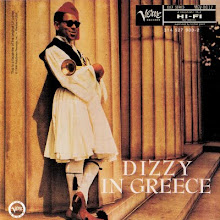The 1950s was the golden era of televised jazz. Nearly all jazz greats of the time appeared on syndicated TV. This post is dedicated to them.
CBS producer Robert Herridge (seen talking on first clip) brought to CBS studio 61 in NYC on April 2, 1959 Miles Davis, John Coltrane, Wynton Kelly, Paul Chambers and Jimmy Cobb to give us their masterpiece "So What".
This date was taped for The Sound of Miles Davis, an installment of The Robert Herridge Theater. Altoist Cannonball Adderley, a regular member of this band, was absent because of a migraine headache, which may explain why Davis solos twice on "So What," both before and after Coltrane. Broadcast on July 21, 1960. A jazz moment to cherish forever.
From the same date as above, Miles Davis, John Coltrane on alto, Jimmy Cobb and Paul Chambers join forces with The Gil Evans Orchestra to give us Dave Brubeck's "The Duke". Big band jazz with a twist indeed!
Personnel:
Miles Davis (tpt, flh); John Coltrane ( as); Paul Chambers (b); Jimmy Cobb (d); Ernie Royal (tpt); Clyde Reisinger (tpt); Louis Mucci (tpt); Johnny Coles (tpt); Emmett Berry (tpt); Frank Rehak (tb); Jimmy Cleveland (tb); Bill Elton (tb); Rod Levitt (valve tb); Julius Watkins (frh); Robert Northern (frh); Bill Barber (tuba); Romeo Penque (cl, fl); Eddie Caine (cl, fl); Danny Bank (bcl); Gil Evans (arr, cond)
Ahmad Jamal's tasty tune "New Rhumba", same personnel as above
Gil Evans' "Blues For Pablo", same personnel as above
That's all for now folks, enjoy.
Sol Schlinger, Baritone Sax Extraordinaire
2 years ago


4 comments:
Nothing too long here.
If you watch James Burke's The Day the Universe Changed, he devotes one episode to the aftershocks of the invention of the printing press. Evidently, before the printing press most people had what we would consider today to be extraordinary memories. They could memorize two pages of text read to them after hearing it just once. That was normal.
After the printing press mankind simply lost this ability to memorize.
Comparing this music to the jazz of today, actually, any music of today, something similar is going on. But I can't quite say what that is. Only that a few, maybe more than a few pieces of the puzzle seem to be missing today. What those pieces are, I don't know. Certainly though, they are valuable pieces and the fact that they are gone is worth more than a few tears.
How can one not agree, that being as good an analogy as any.
You know, something similar happened before radio came to be.
Up to 1930, household entertainment was provided by the piano sitting in the living room. The rare concert attendance aside, people who wanted to entertain themselves had to lean to play the damn thing.
Believe it or not, the US alone, had 12.000 piano manufacturing firms prior to the Depression. Music publishing houses were the equivalent of the record labels of today, BMG is from that era actually.
So yes, people were more knowledgeable about music back then and these videos provide ample evidence.
One can say that this period, the mid fifties, is midway between musical awareness of the past and the total unmusicality prevailing today.
Δεν είχα πάρει χαμπάρι ότι έπαιζε τόσο καλή δουλειά σε τζαζομπλογκ.
Το αγγλικό με ρίχνει λιγουλάκι. Θέλεις και comments αγγλιστί ή επιτρέπονται και τα ελληνικά?
Τεσπα, βρήκα την ασχολία μου για σήμερα το βράδυ. Θενκς
μπα, και τα ελληνικά μια χαρά είναι...
το αγγλικό είναι επειδή έχω έντονη παρουσία στο youtube, και έρχεται κόσμος από εκεί, εξ άλλου αυτή η μουσική δεν είναι και η δημοφιλέστερη στην χώρα της έφης θώδη.
νάσαι καλά.
Post a Comment